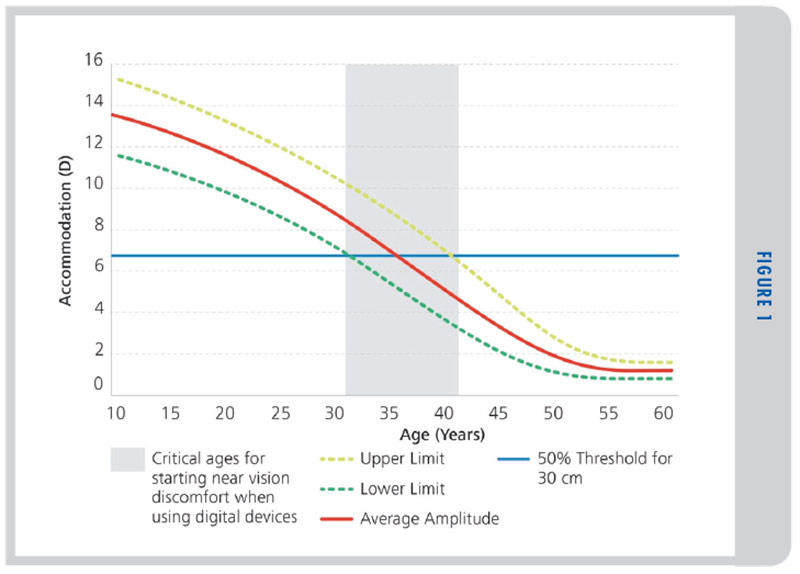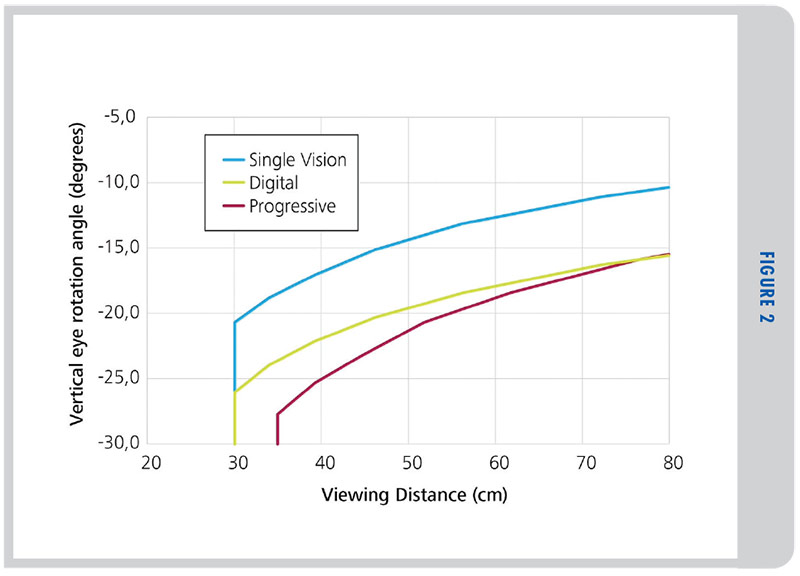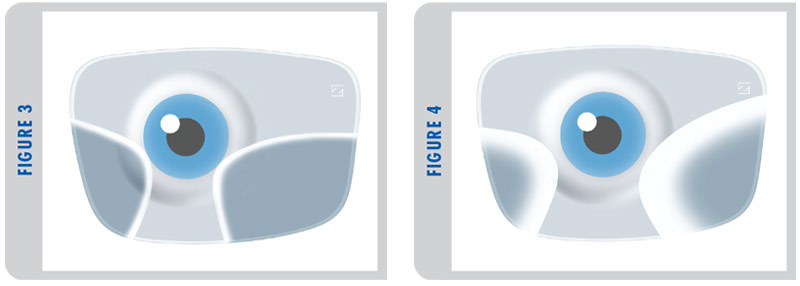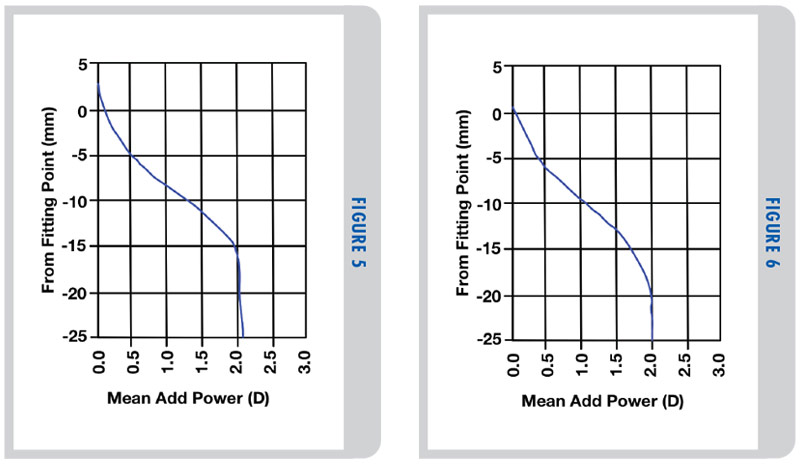BY BRENT MCCARDLE
Today we have a wide variety of lenses from which to choose. But with choices inevitably comes decision fatigue. Often, we will use a lens that seems to work out most of the time. Yet in many cases we could use two different lens designs to provide a better visual and physical experience for the wearer. We perform many different tasks during the day that would benefit from different types of task-specific lenses, such as in driving, computer use, intermediate use and sports. Let’s explore why sticking to one go-to design is not always best.
Our eyes are overworked more today than ever before. We are constantly focusing-refocusing our eyes on handheld digital devices, computers, tablets and printed media. As we age, we lose the ability to focus and refocus with ease; this leads to tired, dry eyes, neck and back pain or digital eye strain.

ACCOMMODATION
Figure 1 shows the loss of amplitude of accommodation as we age. The upper limit is generally for myopes, and the lower limits are for hyperopes. When a single vision wearer uses a handheld digital device, they view the object at a distance of 30 cm, which is equivalent to 3.33 D. Since we keep half of the accommodation in reserve, we need a total of 6.66 D of accommodation to see at 30 cm. The age range at which a wearer begins to lose enough accommodation to be noticeable is anywhere from 32 to 42 years of age.
EARLY PRESBYOPES
With the advent of low power anti-fatigue lenses, we are able to ease the accommodative stress associated with digital eye strain, however, as the amplitude of accommodation decreases with age, it becomes apparent that one type of lens will no longer work optimally for many of our daily tasks.

Figure 2 shows us that a single vision and an anti-fatigue lens wearer, who both focus their eyes at a near point of 30 cm (the typical distance most users hold digital devices) will look down 21 degrees and 26 degrees, respectively. A progressive wearer focusing at 35 cm will look down around 28 degrees. As a general rule, every 2 degrees of eye rotation is equivalent to 1 mm at the spectacle plane—assuming a typical vertex distance of 12 mm. Of course, this rule-of-thumb does not take any pantoscopic tilt, eye center of rotation or back surface power into account. An early presbyope still has the ability to accommodate at an intermediate distance of 80 cm. An anti-fatigue lens will suffice in this case for general wear, however, if they play a specific sport, a progressive lens featuring a longer corridor might be a better option. As with most sports specific tasks, a two pair solution is strongly advised for optimal performance. Anti-fatigue lenses generally have shorter corridors than standard progressives because these wearers are often coming from single vision where their eyes would typically rotate about 10.5 mm for near tasks.
A presbyope who plays golf would clearly prefer to have a progressive so they can see at near. But they do not want that near point too high, this would interfere as they look down to focus on the ball. A longer corridor lens is recommended. Placing the near point further down will also allow for more optimal distribution of the surface astigmatism resulting in wider distance area.
MODERATE PRESBYOPES
Once a wearer’s presbyopia has progressed to 1.50 D, they can no longer successfully use a mild boost, anti-fatigue lens, because their add power is now too high or they might need some assistance in the intermediate area. An add power of 1.75 D to 2.00 D for a hyperope tends to be the point where the wearer will start to notice a tablet or computer screen becomes harder to focus or requires them to tilt their head back uncomfortably to see more clearly. This is the point where recommending two pairs becomes crucial to really help the wearer.
Why 1.75 D? We need 2.50 D of power to read at 40 cm and 1.25 D of power to read at 80 cm or roughly 31.5 inches. If we subtract this 1.75 D add power from 2.50 D, we have 0.75 D. This means the wearer can still accommodate up to 0.75 D, not the full 1.25 D they need for 31.5 inches. A myope’s corresponding breaking point will be around an add power of around 2.25 D. When wearers start to complain about intermediate distance being blurry, or they state they need to tilt their head back too far, we traditionally move them into different progressive designs or switch them to a shorter corridor progressive.
This may appear to resolve the situation at first, but as the near power increases or the corridor length decreases, we decrease the usable width in the intermediate. Although they will say like the shorter corridor, they will also feel they need to move their head more from side to side.
Office or workspace lenses are often the best solution to anyone who uses intermediate and near areas for their work. This could include optometrists, opticians, hair stylists, nurses, etc. We often call these lenses computer lenses; however, it is best to use the term workspace or office lens, as some of these professions may actively utilize the intermediate portion, but they do not use computers all day. Many of these lens types use a design that prioritizes the intermediate portion, but also decreases the usable width in the distance.

Figure 3 shows a hard design, which is meant to enhance the distance area by keeping the astigmatic area relegated to the low lateral areas. Figure 4 shows a soft design where the astigmatism is distributed vertically, thereby increasing the usable width of the intermediate, but also decreasing the width in the distance. Most of these office lenses provide a compensation that requires specifying the upper portion of the lens for a specific distance (i.e., 3 feet, 5 feet, 7 feet, etc.). The compensation is based on the reciprocal of the distance in meters. For example, 7 feet is roughly equivalent to 2 meters, D. Given a distance prescription of +1.00 sph with a +2.00 D add, the resulting power will be compensated to +1.50 sph with a +1.50 add. The adjusted distance power range allows the wearer the ability to walk around their office while regaining quick access to the intermediate and near areas.
Using an office design will reduce head movement both vertically and horizontally due to the increase in distance power and widened intermediate area. Of course, these office designs are meant to be used alongside a general purpose progressive. If the wearer is a true computer user, you may want to recommend a lens that adjusts the upper lens area to two to three feet as most of these wearers have larger screens and/or multiple monitors that tend to be located around 2.5 to 3 feet distance. Some offices have used an anti-fatigue lens to build their own computer lens. In this case, you can split the add power in half, and add this value to the distance prescription.
Progressive wearers also suffer when using a standard progressive while driving at night. With contrast diminished at night, many wearers tend to move their eyes more as opposed to how they move their head during the day. Moving their eyes more in a standard progressive will place their gaze in areas of the lens that are not ideal for low contrast viewing. A person who complains of driving at night needs a lens that has a longer corridor and a progression that starts slightly at or below the fitting cross.

Figure 5 shows a power profile of a general-purpose progressive where the progression starts above the fitting cross (0 on the y axis) and reaches full add power of 2.00 D at 15 mm below the fitting cross. Figure 6 shows a power profile of a distance-emphasized progressive, where the progression starts at the fitting cross, but does not reach full add power until 20 mm below the fitting cross. The distance emphasized-progressive produces a large distance area, with an extremely wide usable intermediate area. Each of these lenses come with a few tradeoffs. The distance-emphasized lens has a much wider usable intermediate area, and its corridor is much longer, which means the rate of power change is far less. The general-purpose progressive does work well for general use. However, for driving at night, the corridor is often too narrow and too short. Power change is the rate at which the progressive changes power over each millimeter. For example, the corridor length for Figure 6 is 20 mm, and the add power is 2.00 D, the rate of change is D per millimeter where Figure 5 has a 13 mm corridor with a 2.00 D add, so the rate of change is D per millimeter.
For individuals who complain about driving at night, you should use a lens specifically designed for driving at night, and the lens should also have a coating to help reduce the blue light glare from both oncoming LED headlights and street lights. Since the corridor is longer on these lenses, and their near point is lower, they should be paired with an office type lens to give the wearer what they need for the specific task they are performing.
Offering multiple lenses should be based on wearer need. One lens will not always be the ideal for all activities, and as ophthalmic professionals, we should advise the wearer of their options. The analogy of wearing different shoes for different activities has been used many times in our profession, however, it still rings true: The best pair of lenses are multiple lenses.■
Brent McCardle is a licensed optician with over 35 years of experience. His role as technical education specialist at Zeiss provides him the opportunity to work on new product innovations with marketing and to work closely with the training of eyecare professionals.












